If the name of our website doesn’t make this obvious, peppers are (by far) our favorite plants to grow. We may not know how to keep our lawn perfectly green and happy, but our peppers always thrive.
In this article, we’ll share some essential tips when it comes to planting peppers. You’ll find when to plant seeds, how deep to plant them, how far apart to space plants and much more.
Note: If you’re looking for an in-depth grow guide from start to finish, try our how to grow peppers from seed article here.
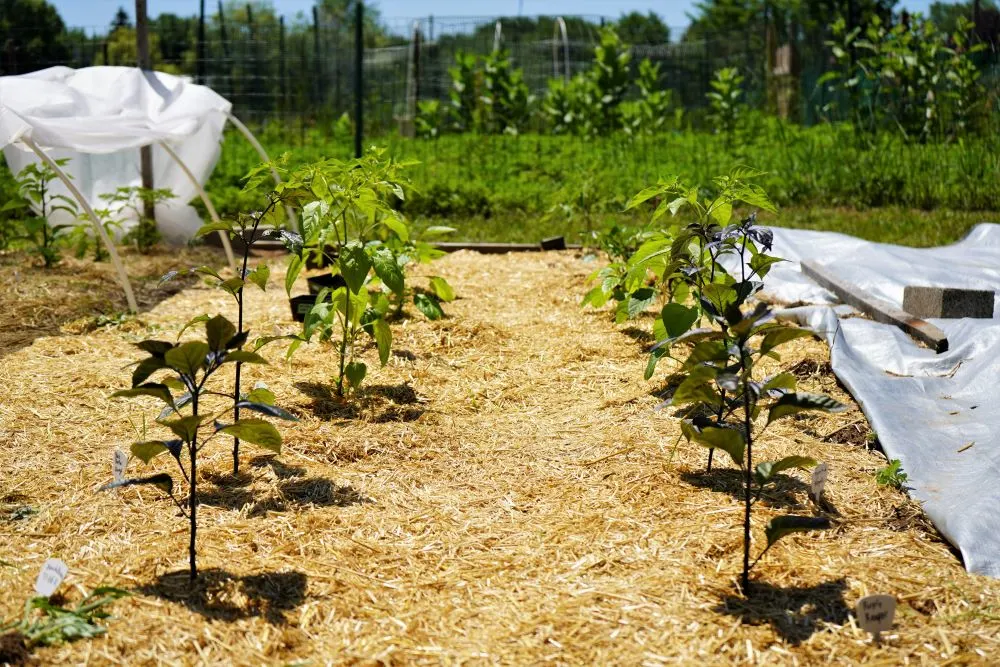
Pepper Varieties
Most pepper varieties are easy to grow. This makes peppers a perfect starter plant for new gardeners. Here are some of the varieties that we recommend starting with.
Sweet peppers
- California Wonder bell pepper
- Orange bell pepper
- Jimmy Nardello sweet pepper
- Golden marconi
- Mini bell pepper
- Sweet banana pepper
Hot peppers (from least to most heat)
- Poblano pepper (ancho)
- Lemon spice (yellow) jalapeno
- Santaka chile pepper
- Habanero orange
- Scotch bonnet
- Ghost pepper
The world of pepper varieties is vast, so feel free to explore the many amazing options. Try browsing some of our favorite seed sellers for varieties that suit your tastes.
Temperature
Ideal temperatures for peppers range from 65°F to 90°F. However, most of the common pepper varieties in North America grow best in warm weather between 70-80°F (21-27°C).
Pepper plants are not cold hardy, so wait to plant peppers outdoors until and cold weather has passed. We usually transplant our pepper plants outside when the temperatures are consistently above 50°F at night.
If your climate has freezing winters, you will likely need to plant seeds indoors, or buy started plants in springtime.
Planting Pepper Seeds
If you are growing from seed, planting peppers indoors is usually necessary. If you live closer to the equator, you may be able to sow outdoors.
For colder climates, plant pepper seeds indoors about 6 weeks before the last chance of frost. The plants should be ready to move outside about 2 weeks after that, so a total of 8 weeks from sowing to transplanting outdoors.
Pepper seeds should be planted about 1/4″ deep. Any deeper, and the seed may struggle to emerge from the soil. Always keep pepper seeds warm and moist during germination. Learn more about germinating pepper seeds here.
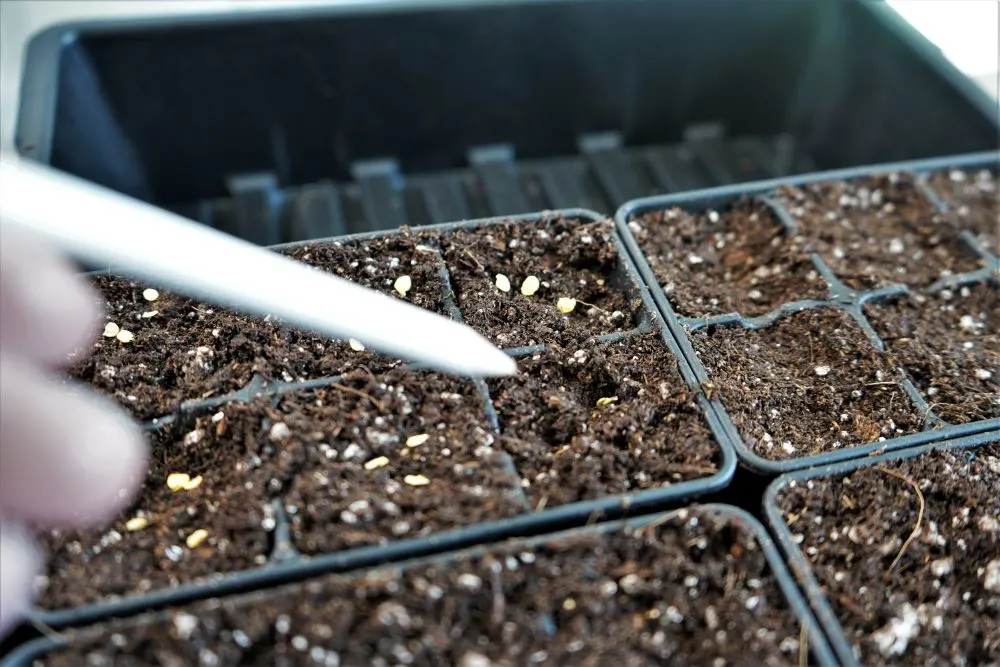
Moving outside requires a transition period called ‘hardening off.’ This basically involved gradually increasing the amount of direct sunlight your plants get daily. Learn more about hardening off here.
Buying Pepper Plants
If you want to grow started plants, be sure to choose plants that look healthy. Look for rich, green leaves and avoid any plants with brown spots or yellowing leaves.
You can also check the root ball by gently lifting the plant out of it’s growing container. If the roots appear dense and tangled, it may be root bound. Try to find plants with roots that are just starting to reach the bottom of the soil.
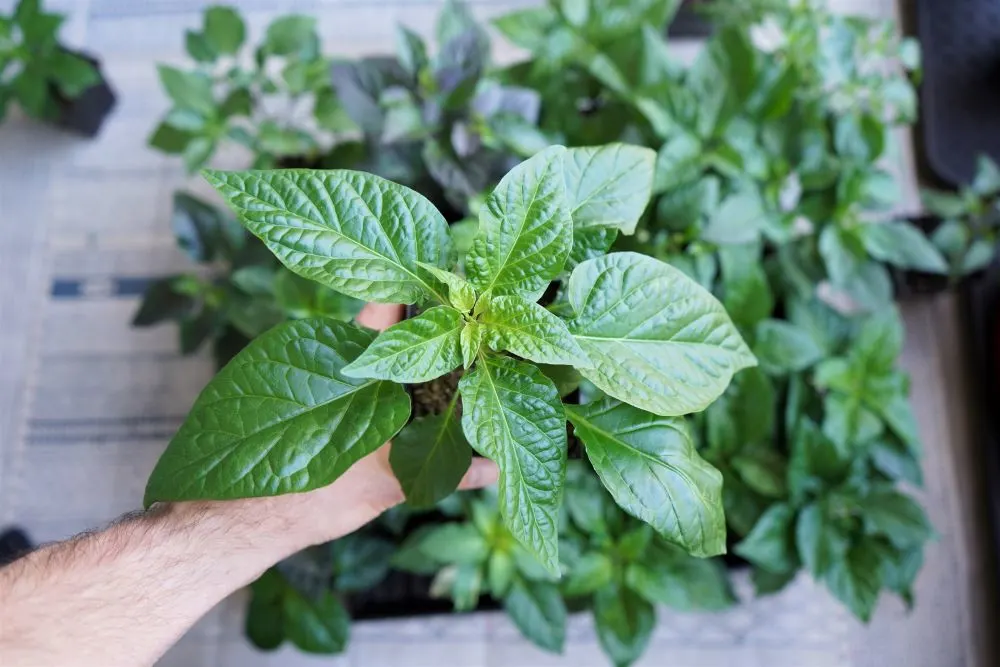
Always buy plants around the time you are ready to transplant. Again, this means nighttime temperatures consistently above 50°F (10°C) and getting warmer.
Pepper Spacing
Some pepper varieties can grow to be very large and bushy, while others remain slender. Ghost peppers and some other C. chinense varieties tend to be the largest, while jalapenos and other C. annuum types are often smaller.
In short, space pepper plants at about 18″ from each other, stem to stem. Leave 2-3 feet (~60-100 cm) between rows so that you have plenty of room to walk between and harvest your plants.
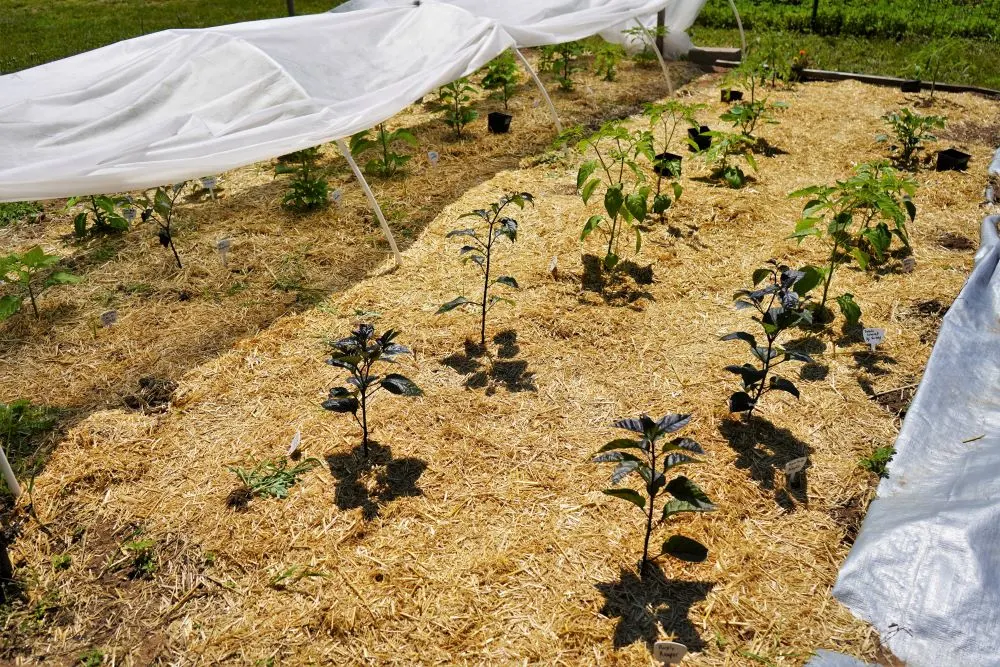
Tip: Mulch the base of in-ground pepper plants to improve water retention and prevent soil from splashing onto leaves.
Container size is important for maximizing your pepper yield. Most pepper plants will grow well in 3-5 gallon (11-19 liter) containers. However, the largest varieties, such as bhut jolokia, can benefit from even larger pots.
Fertilizing
For potted plants, use an all purpose fertilizer like this one. This is especially important during early growth. This ensures the plants grow as big as possible with lots of healthy green foliage.
Note that high-quality potting soil will often have plenty of nutrients for several months. Check your bagged soil to see if additional fertilizer is necessary.
For in-ground peppers, amend the soil with a slow-release granular fertilizer about 2 weeks before transplanting. Use the recommended amount per 100 sq. ft., usually around 2 lbs. of granular fertilizer. Use a rake to work the fertilizer into the first 1-2 inches of soil.
Garden bed soil also benefits greatly from added compost. Make your own compost with simple ingredients like lawn clippings and dried leaves in the fall or early spring.
We recommend reducing nitrogen about halfway through the season. You can either stop fertilizing all together, or switch to a blooming-stage fertilizer.
Watering
Pepper plants like evenly-moist soil. Try to avoid the soil becoming overly moist or completely dry. Check the first 2-3″ of soil and only water when it is dry.
To avoid over-watering, allow potted plants to drain and make sure your garden beds drain well. Raised beds have good drainage by design, but in-ground beds can vary. If your garden does not drain well, you can plant peppers on mounds instead of flush with the ground.
Potted plants will require more frequent watering, as bagged soil tends to dry quickly. To retain moisture for longer, apply a thick mulch using straw or grass clippings.
Common Pests and Diseases
Like all crops, peppers have their enemies. Depending on your location, you may encounter any number of the pests listed below.
Pepper pests:
- Aphids
- Thrips
- Spider mites
- Whiteflies
- Caterpillars
- Slugs and snails
- Grasshoppers
- Weavils
- Scale insects
The best way to deal with pests is to plant a diverse range of companion plants. Having other plants in your garden will attract natural pest predators. Flowers will attract predatory wasps, ladybugs and other pest-eaters.
If a population of pests becomes out of control, spray with garden-safe insecticidal soap. Alternatively, you can release beneficial insects in your garden to help keep the pests down. Just be sure to know which pest you have and which predator will work best.
Diseases can be equally devastating to pepper plants. They can be introduced through soil pathogens, transmitted via pests, or through cross contamination. Here are a few diseases known to affect pepper plants.
Pepper diseases:
- Pepper leaf spot
- Anthracnose
- Blight
- Mosaic virus
- Damping off (young plants especially vulnerable)
Take precautions by practicing good hygiene in the garden, cleaning tools at the end of the season, and mulching to avoid splashing on low leaves. We also recommend bottom pruning lower leaves for the same reason.
Pepper Growing Tips
While peppers tend to be easy to grow, there are some tips to help keep your plants happy and healthy. Here are some simple techniques to improve your pepper planting.
- Stake your plants. Staking is done to provide support for your plants. As the peppers form and the plants grow taller, they become susceptible to winds. Avoid broken branches by staking plants with a sturdy stake, attaching the plant with garden velcro or string.
- Don’t over fertilize. Too much fertilizer can attract pests and damage pepper plants. Only fertilize when necessary and try to lean towards under-feeding.
- Don’t over-water. Allow plants to drain wall after rainfall or irrigation. Remove bottom saucers from potted plants to allow the water to drain. For in-ground beds, test soil for drainage and plant on mounds if necessary. Raised beds have good drainage by design.
- Use grow lights for seedlings. Growing pepper seedlings in a sunny window is not ideal for early growth. While not required, a grow light will ensure early plants get the energy they need to thrive. Plus, using a light means your seedlings can be grown in a room without windows.
- Transplant at the right time. Seedlings should be transplanted as soon as they outgrow their containers. Usually, peppers outgrow seed cell trays after the first 2-3 weeks of growth. Check the roots carefully to see if they are reaching the bottom of the pot.
- Pick early pepper pods. If your small plants are beginning to produce peppers, pick them off. These small pods will stunt the growth of the plant, leading to a smaller harvest.
For more tips and a detailed growing guide, use our growing peppers guide here.
Harvesting Peppers
Depending on the variety of plant, your peppers should begin to ripen about 60-90+ days after transplanting outdoors. If you are growing rocotos or any of the superhots, you may have to wait 120+ days from transplanting!
All peppers change color when they are fully ripe. If you are saving seeds for planting next year, wait for full ripeness to pick. Other types are commonly picked early for a crunchier texter and more vegetal flavor.
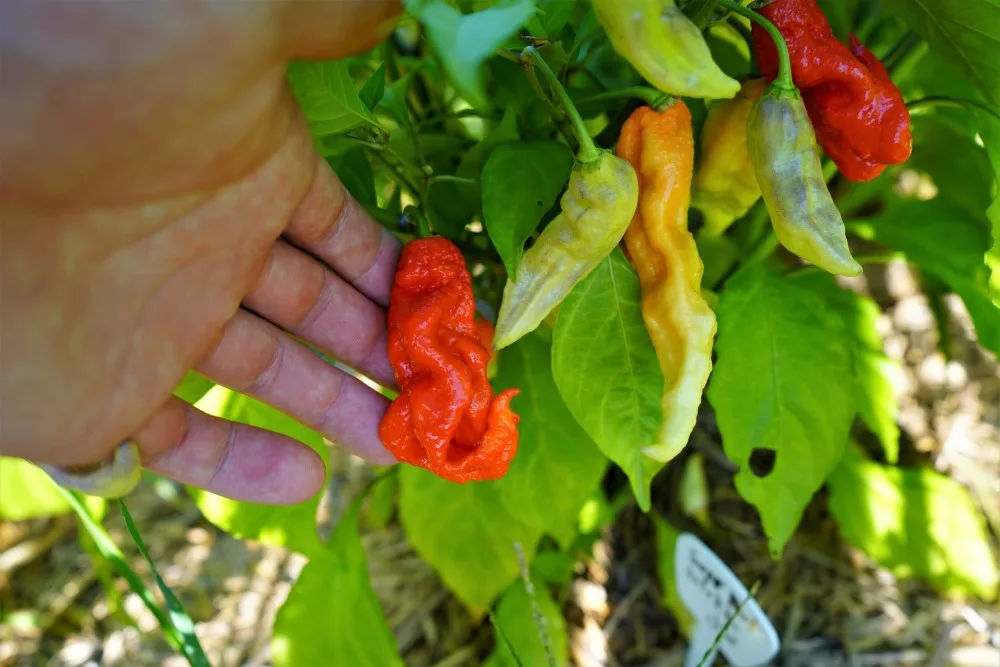
I hope this guide helps you with planting peppers this year. If you have questions, feel free to comment below.

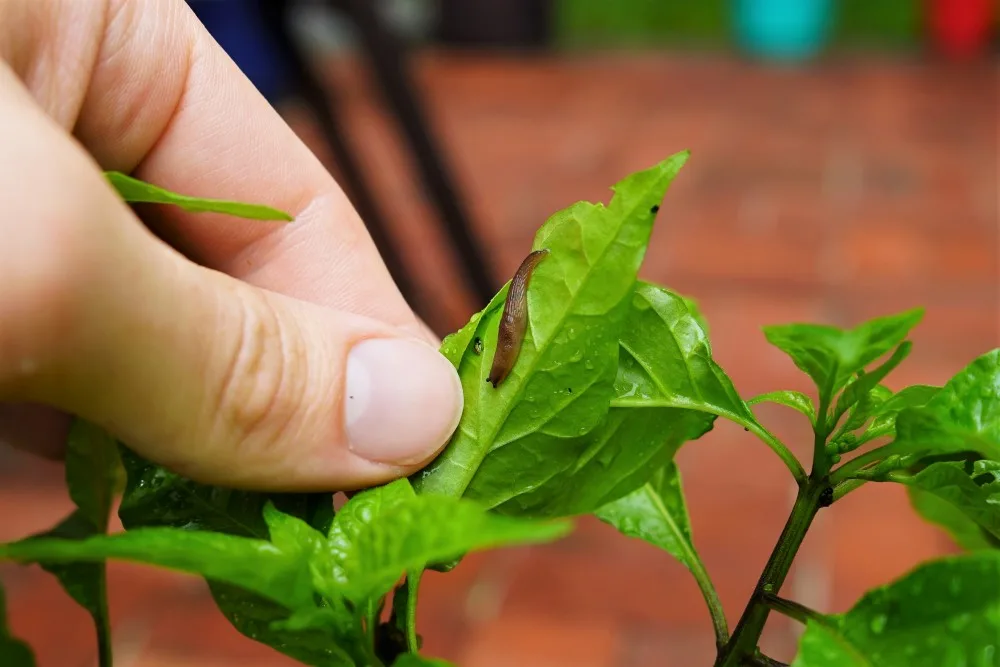
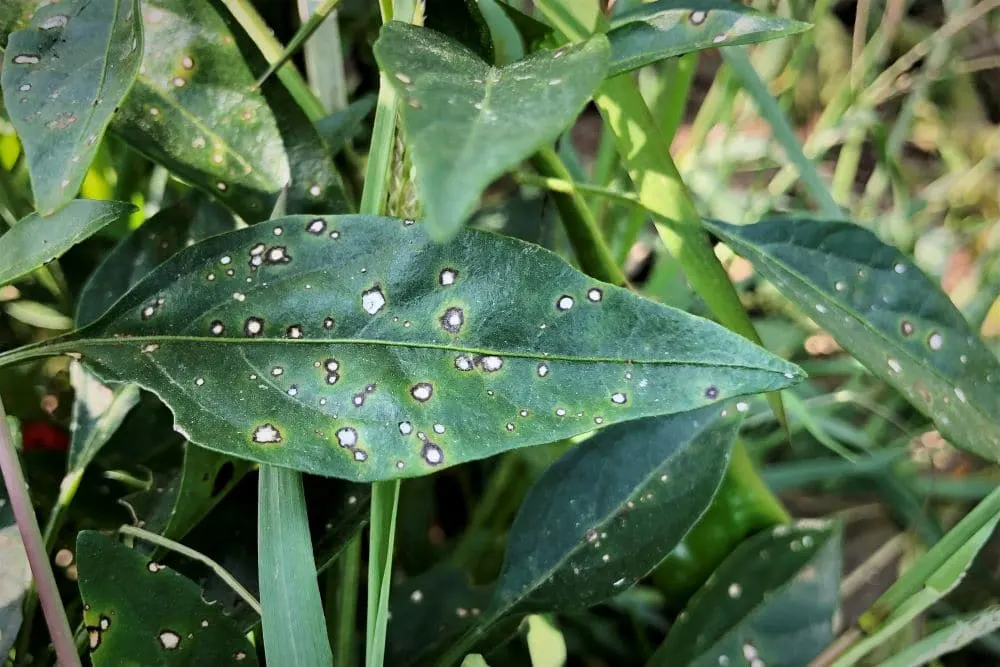

Aaron
Sunday 8th of May 2022
Have you ever grown rocoto peppers or escabeche chilies from Peru? If so, where did you get your seeds? My wife is Peruvian and we have to drive several hours just to find a store that we can buy frozen quantities of these plants. I would love to try and grow them fresh.
peppergeek
Friday 13th of May 2022
We are growing a few rocoto varieties this year and got our seeds from semillas.de (Semillas La Palma).
Niecie
Friday 6th of May 2022
My peppers are getting too big for their 4" pots but the weather is still too cold to plant outdoors. Should I repot to larger container or plant outside in my raised beds and cover with greenhouse plastic until weather warms up?
peppergeek
Sunday 8th of May 2022
It depends how much time you have to wait. We always end up with some plants that are overgrown for their pots, just because we don't have room. If you have the space and soil, you should uppot whenever the plant is ready for it to allow it to keep growing bigger. Then, when the time comes, get it outside.
ndibieh Oliver tabah
Monday 11th of October 2021
Having slot problems in my garden right now
peppergeek
Tuesday 12th of October 2021
What do you mean by slot?